2010 SUBARU TRIBECA ECU
[x] Cancel search: ECUPage 10 of 422
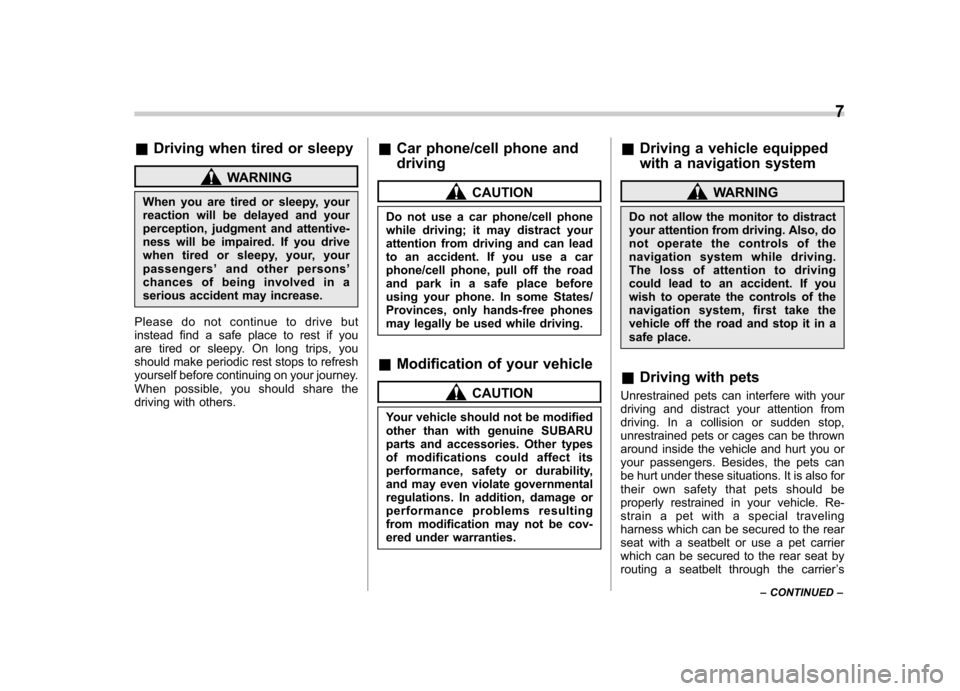
&Driving when tired or sleepy
WARNING
When you are tired or sleepy, your
reaction will be delayed and your
perception, judgment and attentive-
ness will be impaired. If you drive
when tired or sleepy, your, your
passengers ’and other persons ’
chances of being involved in a
serious accident may increase.
Please do not continue to drive but
instead find a safe place to rest if you
are tired or sleepy. On long trips, you
should make periodic rest stops to refresh
yourself before continuing on your journey.
When possible, you should share the
driving with others. &
Car phone/cell phone and driving
CAUTION
Do not use a car phone/cell phone
while driving; it may distract your
attention from driving and can lead
to an accident. If you use a car
phone/cell phone, pull off the road
and park in a safe place before
using your phone. In some States/
Provinces, only hands-free phones
may legally be used while driving.
& Modification of your vehicle
CAUTION
Your vehicle should not be modified
other than with genuine SUBARU
parts and accessories. Other types
of modifications could affect its
performance, safety or durability,
and may even violate governmental
regulations. In addition, damage or
performance problems resulting
from modification may not be cov-
ered under warranties. &
Driving a vehicle equipped
with a navigation system
WARNING
Do not allow the monitor to distract
your attention from driving. Also, do
not operate the controls of the
navigation system while driving.
The loss of attention to driving
could lead to an accident. If you
wish to operate the controls of the
navigation system, first take the
vehicle off the road and stop it in a
safe place.
& Driving with pets
Unrestrained pets can interfere with your
driving and distract your attention from
driving. In a collision or sudden stop,
unrestrained pets or cages can be thrown
around inside the vehicle and hurt you or
your passengers. Besides, the pets can
be hurt under these situations. It is also for
their own safety that pets should be
properly restrained in your vehicle. Re-
strain a pet with a special traveling
harness which can be secured to the rear
seat with a seatbelt or use a pet carrier
which can be secured to the rear seat by
routing a seatbelt through the carrier ’s
7
– CONTINUED –
Page 22 of 422

&Warning and indicator lights
Mark Name Page
Driver ’s seatbelt warning
light 3-10
Front passenger
’s seat-
belt warning light 3-10
SRS airbag system
warning light 3-11
CHECK ENGINE warn-
ing light/Malfunction indi-
cator lamp3-12
Charge warning light 3-13
Oil pressure warning light 3-13
AT OIL TEMP warning light
3-13
/ABS warning light 3-15
/Brake system warning light
3-16
Door open warning light
3-17Mark Name Page
Low fuel warning light 3-17
AWD warning light 3-18
Vehicle Dynamics Con-
trol operation indicator light
3-18
Vehicle Dynamics Con-
trol warning light/Traction
Control system OFF in-
dicator light3-18
Security indicator light 3-19
Turn signal indicator lights
3-20
High beam indicator light 3-20
Front fog light indicator light3-21
Headlight indicator light 3-21
Cruise control indicator light3-20Mark Name Page
Cruise control set indica-
tor light
3-21
Low tire pressure warn-
ing light3-14
Passenger airbag ON in-
dicator light
3-12
Passenger airbag OFF
indicator light3-12
SPORT mode indicator light
3-20
Windshield washer fluid
warning light3-18
Rear differential oil tem-
perature warning light3-1419
– CONTINUED –
Page 29 of 422
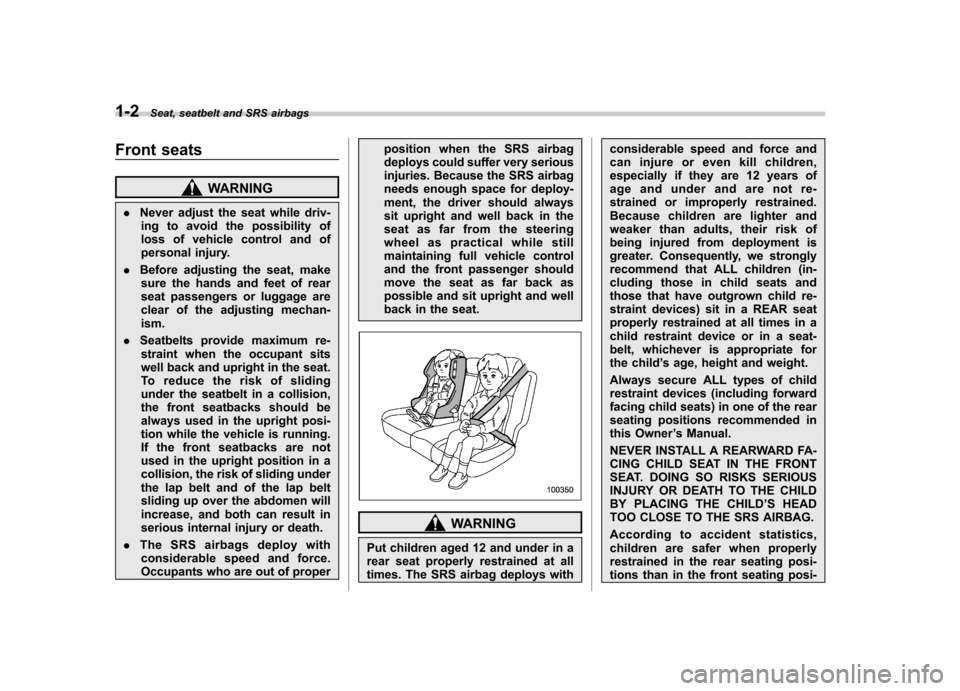
1-2Seat, seatbelt and SRS airbags
Front seats
WARNING
. Never adjust the seat while driv-
ing to avoid the possibility of
loss of vehicle control and of
personal injury.
. Before adjusting the seat, make
sure the hands and feet of rear
seat passengers or luggage are
clear of the adjusting mechan-ism.
. Seatbelts provide maximum re-
straint when the occupant sits
well back and upright in the seat.
To reduce the risk of sliding
under the seatbelt in a collision,
the front seatbacks should be
always used in the upright posi-
tion while the vehicle is running.
If the front seatbacks are not
used in the upright position in a
collision, the risk of sliding under
the lap belt and of the lap belt
sliding up over the abdomen will
increase, and both can result in
serious internal injury or death.
. The SRS airbags deploy with
considerable speed and force.
Occupants who are out of proper position when the SRS airbag
deploys could suffer very serious
injuries. Because the SRS airbag
needs enough space for deploy-
ment, the driver should always
sit upright and well back in the
seat as far from the steering
wheel as practical while still
maintaining full vehicle control
and the front passenger should
move the seat as far back as
possible and sit upright and well
back in the seat.
WARNING
Put children aged 12 and under in a
rear seat properly restrained at all
times. The SRS airbag deploys with considerable speed and force and
can injure or even kill children,
especially if they are 12 years of
age and under and are not re-
strained or improperly restrained.
Because children are lighter and
weaker than adults, their risk of
being injured from deployment is
greater. Consequently, we strongly
recommend that ALL children (in-
cluding those in child seats and
those that have outgrown child re-
straint devices) sit in a REAR seat
properly restrained at all times in a
child restraint device or in a seat-
belt, whichever is appropriate for
the child
’s age, height and weight.
Always secure ALL types of child
restraint devices (including forward
facing child seats) in one of the rear
seating positions recommended in
this Owner ’s Manual.
NEVER INSTALL A REARWARD FA-
CING CHILD SEAT IN THE FRONT
SEAT. DOING SO RISKS SERIOUS
INJURY OR DEATH TO THE CHILD
BY PLACING THE CHILD ’S HEAD
TOO CLOSE TO THE SRS AIRBAG.
According to accident statistics,
children are safer when properly
restrained in the rear seating posi-
tions than in the front seating posi-
Page 35 of 422
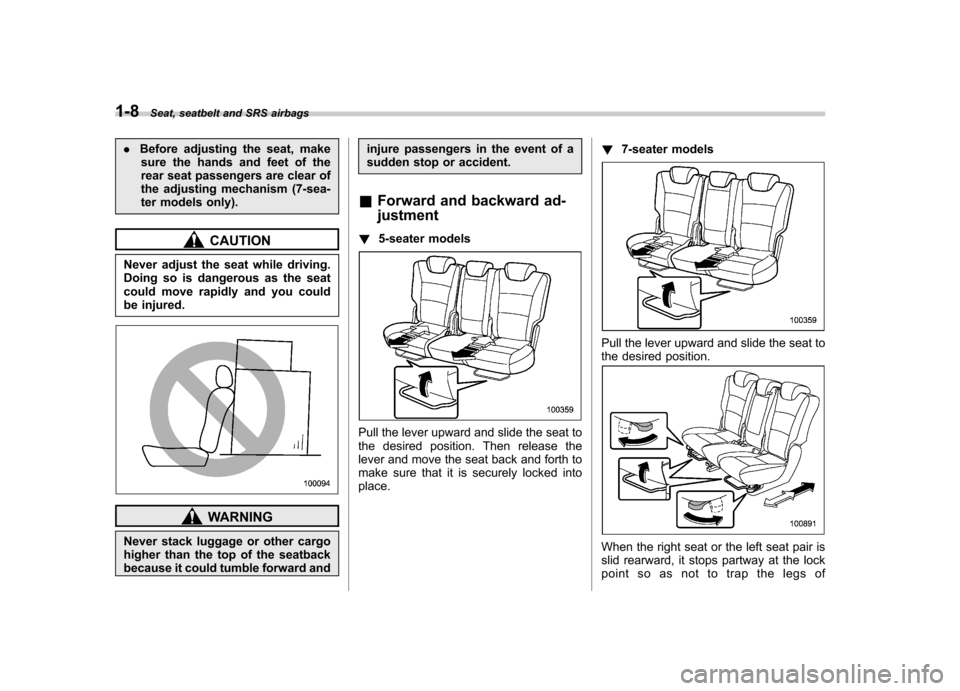
1-8Seat, seatbelt and SRS airbags
.Before adjusting the seat, make
sure the hands and feet of the
rear seat passengers are clear of
the adjusting mechanism (7-sea-
ter models only).
CAUTION
Never adjust the seat while driving.
Doing so is dangerous as the seat
could move rapidly and you could
be injured.
WARNING
Never stack luggage or other cargo
higher than the top of the seatback
because it could tumble forward and injure passengers in the event of a
sudden stop or accident.
& Forward and backward ad- justment
! 5-seater models
Pull the lever upward and slide the seat to
the desired position. Then release the
lever and move the seat back and forth to
make sure that it is securely locked intoplace. !
7-seater models
Pull the lever upward and slide the seat to
the desired position.
When the right seat or the left seat pair is
slid rearward, it stops partway at the lock
point so as not to trap the legs of
Page 36 of 422
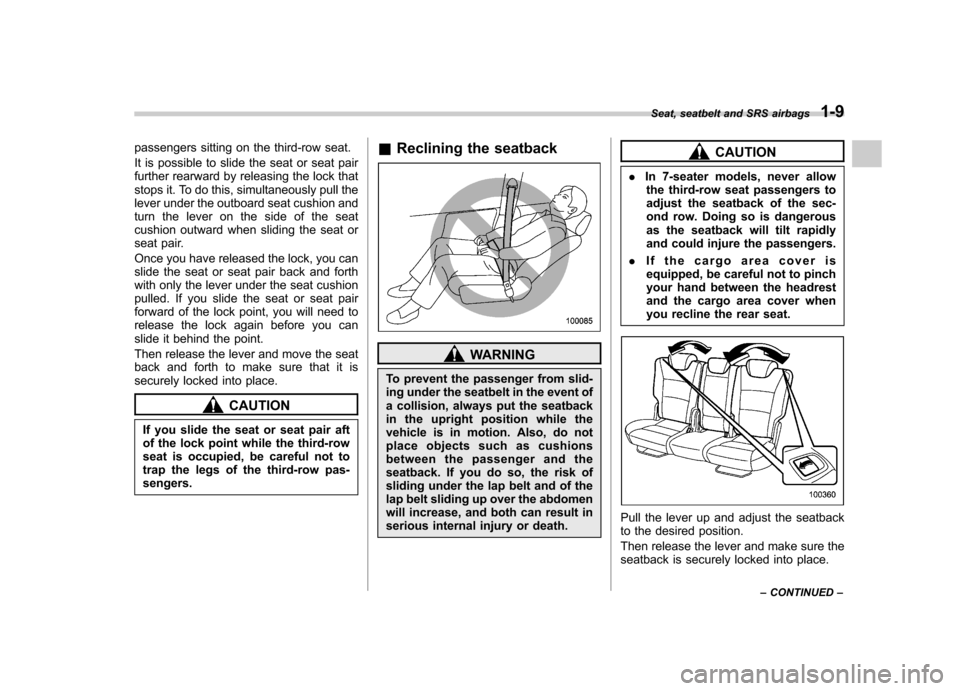
passengers sitting on the third-row seat.
It is possible to slide the seat or seat pair
further rearward by releasing the lock that
stops it. To do this, simultaneously pull the
lever under the outboard seat cushion and
turn the lever on the side of the seat
cushion outward when sliding the seat or
seat pair.
Once you have released the lock, you can
slide the seat or seat pair back and forth
with only the lever under the seat cushion
pulled. If you slide the seat or seat pair
forward of the lock point, you will need to
release the lock again before you can
slide it behind the point.
Then release the lever and move the seat
back and forth to make sure that it is
securely locked into place.
CAUTION
If you slide the seat or seat pair aft
of the lock point while the third-row
seat is occupied, be careful not to
trap the legs of the third-row pas-sengers. &
Reclining the seatback
WARNING
To prevent the passenger from slid-
ing under the seatbelt in the event of
a collision, always put the seatback
in the upright position while the
vehicle is in motion. Also, do not
place objects such as cushions
between the passenger and the
seatback. If you do so, the risk of
sliding under the lap belt and of the
lap belt sliding up over the abdomen
will increase, and both can result in
serious internal injury or death.
CAUTION
. In 7-seater models, never allow
the third-row seat passengers to
adjust the seatback of the sec-
ond row. Doing so is dangerous
as the seatback will tilt rapidly
and could injure the passengers.
. If the cargo area cover is
equipped, be careful not to pinch
your hand between the headrest
and the cargo area cover when
you recline the rear seat.
Pull the lever up and adjust the seatback
to the desired position.
Then release the lever and make sure the
seatback is securely locked into place. Seat, seatbelt and SRS airbags
1-9
– CONTINUED –
Page 37 of 422
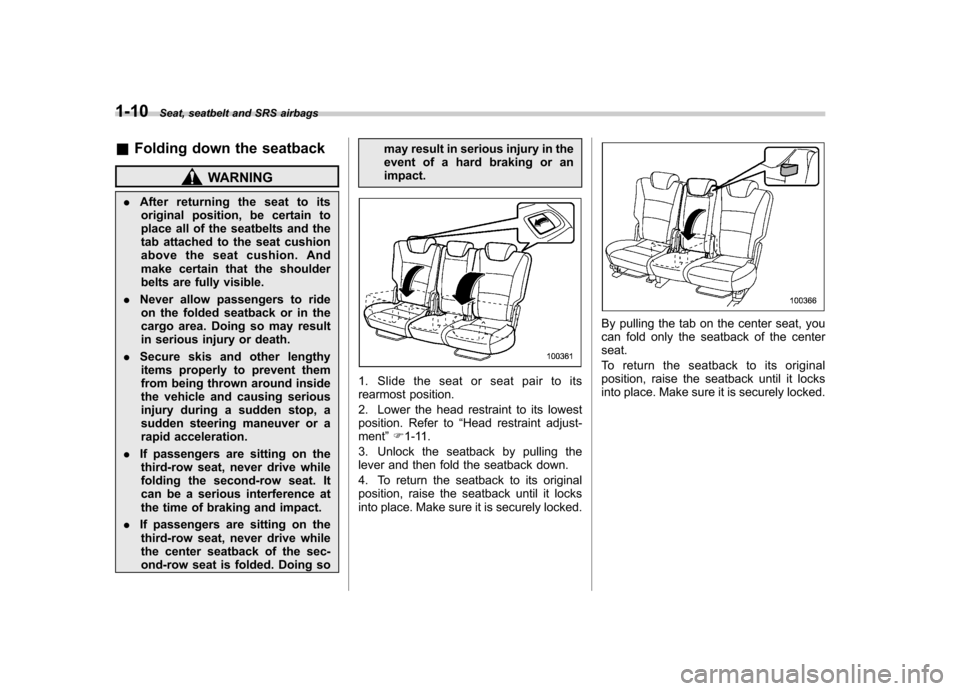
1-10Seat, seatbelt and SRS airbags
&Folding down the seatback
WARNING
. After returning the seat to its
original position, be certain to
place all of the seatbelts and the
tab attached to the seat cushion
above the seat cushion. And
make certain that the shoulder
belts are fully visible.
. Never allow passengers to ride
on the folded seatback or in the
cargo area. Doing so may result
in serious injury or death.
. Secure skis and other lengthy
items properly to prevent them
from being thrown around inside
the vehicle and causing serious
injury during a sudden stop, a
sudden steering maneuver or a
rapid acceleration.
. If passengers are sitting on the
third-row seat, never drive while
folding the second-row seat. It
can be a serious interference at
the time of braking and impact.
. If passengers are sitting on the
third-row seat, never drive while
the center seatback of the sec-
ond-row seat is folded. Doing so may result in serious injury in the
event of a hard braking or animpact.
1. Slide the seat or seat pair to its
rearmost position.
2. Lower the head restraint to its lowest
position. Refer to
“Head restraint adjust-
ment ”F 1-11.
3. Unlock the seatback by pulling the
lever and then fold the seatback down.
4. To return the seatback to its original
position, raise the seatback until it locks
into place. Make sure it is securely locked.
By pulling the tab on the center seat, you
can fold only the seatback of the centerseat.
To return the seatback to its original
position, raise the seatback until it locks
into place. Make sure it is securely locked.
Page 41 of 422
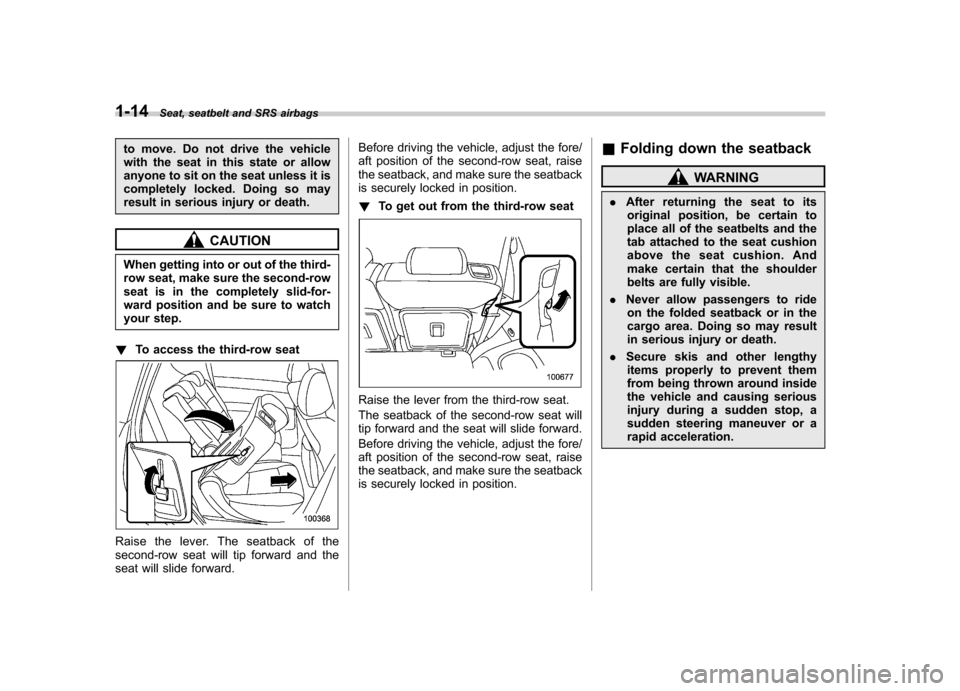
1-14Seat, seatbelt and SRS airbags
to move. Do not drive the vehicle
with the seat in this state or allow
anyone to sit on the seat unless it is
completely locked. Doing so may
result in serious injury or death.
CAUTION
When getting into or out of the third-
row seat, make sure the second-row
seat is in the completely slid-for-
ward position and be sure to watch
your step.
! To access the third-row seat
Raise the lever. The seatback of the
second-row seat will tip forward and the
seat will slide forward. Before driving the vehicle, adjust the fore/
aft position of the second-row seat, raise
the seatback, and make sure the seatback
is securely locked in position. !
To get out from the third-row seat
Raise the lever from the third-row seat.
The seatback of the second-row seat will
tip forward and the seat will slide forward.
Before driving the vehicle, adjust the fore/
aft position of the second-row seat, raise
the seatback, and make sure the seatback
is securely locked in position. &
Folding down the seatback
WARNING
. After returning the seat to its
original position, be certain to
place all of the seatbelts and the
tab attached to the seat cushion
above the seat cushion. And
make certain that the shoulder
belts are fully visible.
. Never allow passengers to ride
on the folded seatback or in the
cargo area. Doing so may result
in serious injury or death.
. Secure skis and other lengthy
items properly to prevent them
from being thrown around inside
the vehicle and causing serious
injury during a sudden stop, a
sudden steering maneuver or a
rapid acceleration.
Page 42 of 422
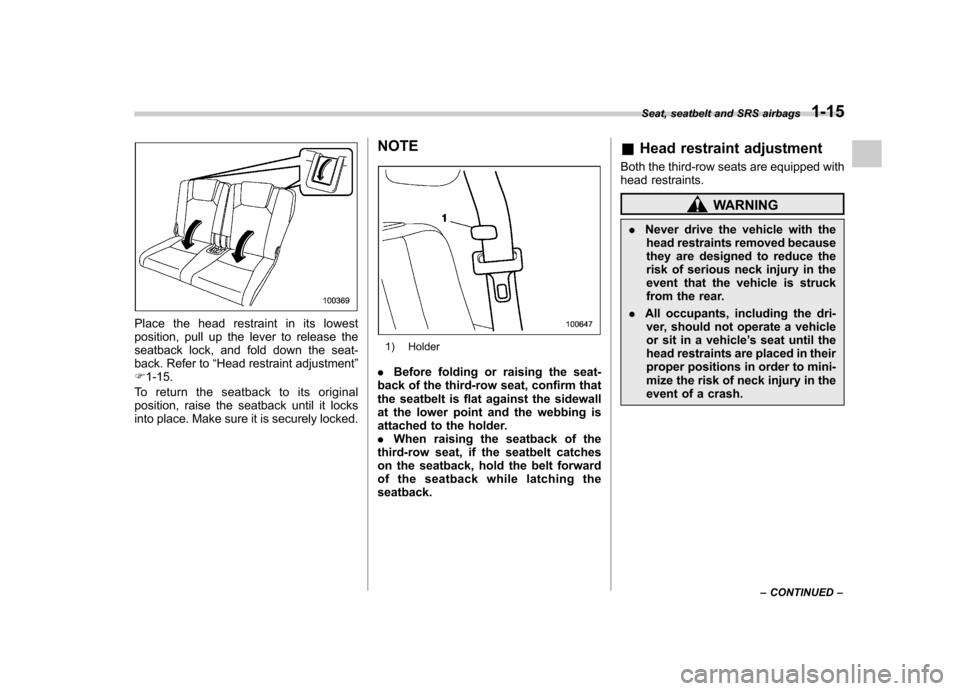
Place the head restraint in its lowest
position, pull up the lever to release the
seatback lock, and fold down the seat-
back. Refer to“Head restraint adjustment ”
F 1-15.
To return the seatback to its original
position, raise the seatback until it locks
into place. Make sure it is securely locked. NOTE
1) Holder
. Before folding or raising the seat-
back of the third-row seat, confirm that
the seatbelt is flat against the sidewall
at the lower point and the webbing is
attached to the holder.. When raising the seatback of the
third-row seat, if the seatbelt catches
on the seatback, hold the belt forward
of the seatback while latching theseatback. &
Head restraint adjustment
Both the third-row seats are equipped with
head restraints.
WARNING
. Never drive the vehicle with the
head restraints removed because
they are designed to reduce the
risk of serious neck injury in the
event that the vehicle is struck
from the rear.
. All occupants, including the dri-
ver, should not operate a vehicle
or sit in a vehicle ’s seat until the
head restraints are placed in their
proper positions in order to mini-
mize the risk of neck injury in the
event of a crash.
Seat, seatbelt and SRS airbags
1-15
– CONTINUED –